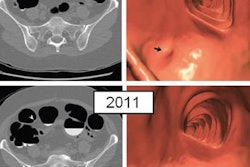
More than 20% of polyps detected at CT colonography (CTC) may be missed at subsequent optical colonoscopy, according to a study in Radiology. What's more, most of the missed polyps were large and clinically significant.
Researchers from the University of Wisconsin in Madison performed CTC (also known as virtual colonoscopy) in nearly 10,000 adults, reviewing more than 1,600 polyps for which patients underwent subsequent optical colonoscopy to confirm positivity. Among the lesions that showed up on one exam but not the other, 21.5% were confirmed as false negatives at optical colonoscopy, with an average size of 8.5 mm in diameter.
"Most [false-negative] findings found with [optical colonoscopy] demonstrated clinically significant histopathologic results," wrote Dr. Dustin Pooler and colleagues Dr. Perry Pickhardt, Dr. David Kim, Dr. Jennifer Weiss, and Dr. Kristina Matkowskyj, PhD (Radiology, August 19, 2015).
An important question
Missed colorectal lesions are important because they may progress to cancer. With optical colonoscopy, follow-up is not routinely recommended for 10 years after the initial exam, by which time malignant transformation may have occurred, the authors wrote.
The miss rate at optical colonoscopy has been studied previously, but the research had limitations. For example, Rex et al estimated a miss rate of 13% for smaller adenomas and 6% for larger ones, but they only used optical colonoscopy for the exams.
 University of Wisconsin investigators Dr. Dustin Pooler (left) and Dr. Perry Pickhardt.
University of Wisconsin investigators Dr. Dustin Pooler (left) and Dr. Perry Pickhardt.Wide variations in optical colonoscopy detection are especially prevalent for proximal serrated polyps, which are often missed at optical colonoscopy and may account for at least part of the dominance of right-sided colorectal cancers, according to the authors.
In most studies, missed lesions have been assumed to be false-positive CTC findings. Still, not all cases have been unequivocally confirmed with optical colonoscopy, leaving a number of cases with unknown status.
"This paper was a culmination of many years of sending patients to optical colonoscopy and trying to follow up the 'CT false positive versus optical colonoscopy false negative' question -- i.e., is it our call or their miss?" Pickhardt wrote in an email to AuntMinnie.com. "A fair number are optical colonoscopy misses, but it's very hard to prove, as many cases remain in limbo without ultimate optical colonoscopy proof" that may never come.
In the current study, 9,336 adult patients (4,210 men, 5,126 women; mean age, 57.1 years) underwent a total of 10,976 screening CTC exams. CTC detected 2,606 polyps that were 6 mm or larger. Unblinded optical colonoscopy was then performed for 1,607 of the 2,606 polyps, while 74 patients had flexible sigmoidoscopy and 50 patients went directly to surgery. The remaining 875 polyps received CTC surveillance.
Of the 1,731 polyps that underwent endoscopic or surgical follow-up, 181 (10%) were not confirmed and were therefore considered discordant; 37 of these were later excluded. After a polyp review, 66 of the 144 lesions were categorized as probable CTC false-positive findings, and 78 were categorized as potential colonoscopy false-negative findings.
In all, 31 (21.5%) of the 144 discordant lesions were confirmed as false negatives at optical colonoscopy, including 40% (31 of 78) in patients who had optical colonoscopy and/or CTC follow-up, the authors reported.
Big ones, too
False-negative optical colonoscopy lesions measured an average of 8.5 ± 3.3 mm and were found at higher confidence levels at CTC (2.8 versus 2.3 on a scale of 1 to 3, p = 0.01). Lesions missed at optical colonoscopy were also more likely to be located in the right colon (71% versus 47% in the left colon, p = 0.10).
Most of the lesions missed with optical colonoscopy that were ultimately resected were neoplastic, and about half of these showed advanced histopathologic traits, the authors noted.
"Interestingly, this study also shows that performance in published CTC trials is underestimated, as all lesions not seen at the optical colonoscopy reference standard are considered CT false positives, even if they are identified using segmental unblinding," Pickhardt wrote in his email. It takes time, he added, to work through all of the optical colonoscopy false negatives.



















